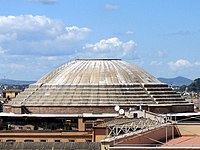
Photo from wikipedia
Abstract The application of oil-contaminated sand (OCS) in concrete is considered a highly sustainable solution and cost-effective recycling method for minimising its negative effect to the environment. The present study… Click to show full abstract
Abstract The application of oil-contaminated sand (OCS) in concrete is considered a highly sustainable solution and cost-effective recycling method for minimising its negative effect to the environment. The present study investigated the mechanical characteristics, strength development, hydration and microstructure of cement mortar containing oil-contaminated sand. The parameters investigated in the present study are the level of oil contamination, mixing method, water-to-cement (w/c) ratio, and the age of curing. The microstructural characteristics of hardened samples, physical and mechanical properties and the strength development pattern of cement mortar containing oil-contaminated sand were assessed up to 365 days. Result shows that the presence of crude oil up to 4% can improve the properties of mortar compare to the uncontaminated samples. The mixing of water and cement before adding oil-contaminated sand is found effective method of mixing, while the optimum compressive strength obtained at a w/c ratio of 0.5. The strength of cement-based mortar having contaminated sand with 2% light crude-oil is similar to the cement mortar with uncontaminated sand after one year. However, the rate of gaining strength of cement mortar with high levels of contamination with light crude oil (4–10%) is found slow. The microstructure of mortar containing contaminated fine sand up to 2% oil appeared to be quite dense and have a finer pore structure. The interfacial tension zone (ITZ) is not affected by crude oil up to 2%, however, the higher percentages of oil contamination (6–10%) can increase the porosity and affect the ITZ.
Journal Title: Construction and Building Materials
Year Published: 2020
Link to full text (if available)
Share on Social Media: Sign Up to like & get
recommendations!